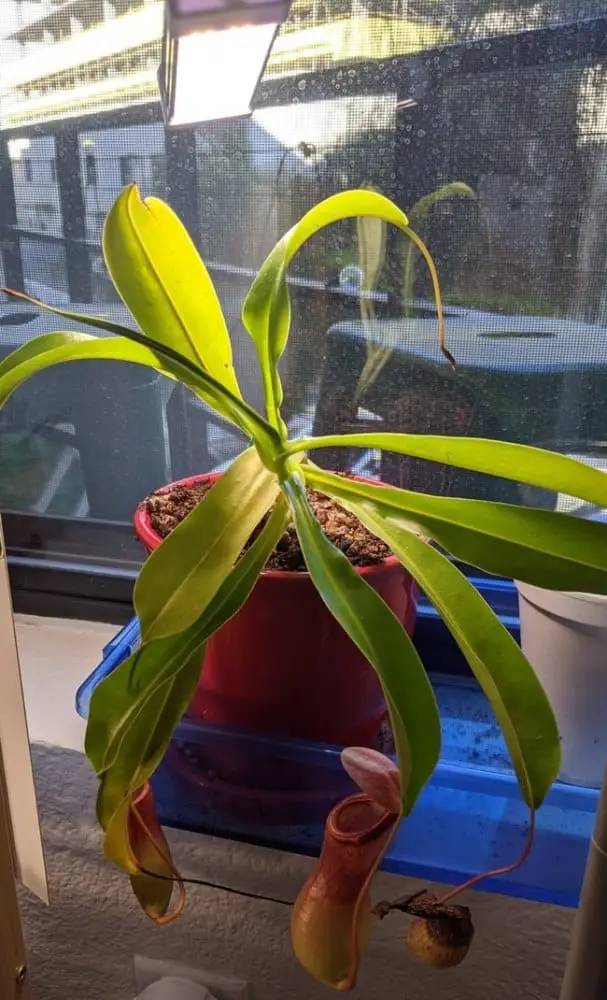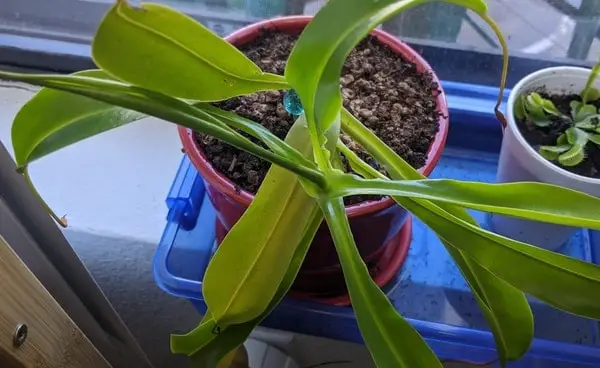Owners of pitcher plants can become alarmed when they don’t see new growth of pitchers directly after the plant sheds its pitchers. Many pitcher plant owners will assume that if there aren’t any pitchers present on the plant, that the plant will soon starve.
Pitcher plants stop producing pitchers when they are grown under improper conditions. Pitcher plants growing in an environment with insufficient humidity, lack of adequate lighting, and improper watering can stop producing pitchers and weaken over time.
It is helpful to understand the reason that your pitcher plant stopped producing pitchers, and this article will fully explain the possible reasons for this phenomenon to occur. In addition, the article will cover the possible remedies so that you may get your pitcher plant blooming again in just a short period of time.
And, if you are looking for more information on pitcher plant care guide, read this complete guide.
Why Is My Pitcher Plant Not Producing Pitchers?
There is a multitude of reasons that a pitcher plant can stop producing pitchers for a short period of time in its growth cycle. Fortunately, only a few of those reasons can be life-threatening to your plant. However, with the fickle nature of the pitcher plant, many owners naturally assume the worst when their carnivorous plant seems to have no means to feed itself.
The most common reason for pitcher plants to lose their pitchers is a lack of the critical amount of direct sunlight that carnivorous plants need to absorb in order to maintain their normal growth and recovery rate.
Most varieties of pitcher plants will need a minimum of 8 hours of direct sunlight in order to stay healthy and vibrant, regardless of if they live indoors or outdoors. You can employ natural light or artificial lighting to fulfill the plant’s requirements.

Pitcher plants are also very delicate when it comes to their watering habits.
Pitcher plants are very sensitive to the additives and minerals that are found in tap and bottled waters. You should water your carnivorous plants with rainwater, distilled water, or reverse osmosis water. This is the case regardless of the soil blend that your pitcher plant is growing in.
Humidity is a very necessary element to a thriving pitcher plant. Unless you are growing your pitcher plant indoors with a humidifier directly beside it, you will need to regularly monitor the humidity of the environment. A great way to maintain a healthy level of humidity is to regularly spritz the plant in its entirety with caught rainwater by using a spray bottle.
If you have verified that the previous conditions aren’t at unacceptable levels, you can explore other care considerations. This article provides a complete guide for growing Pitcher Plants. You can go over each care instruction and confirm you are on the right track.
How Can You Encourage Pitcher Growth For Your Plant?
In order to encourage new pitcher growth from your carnivorous plant, inspect its growing conditions. First, check the humidity requirements.
Incorrect humidity, lighting, watering, or temperatures are common factors that affect Pitcher plant growth. To promote growth, ensure that the plant is in the correct humidity for the specific genus. Then, continue to analyze and adjust its growing conditions.
Sunlight: As with any gardening you choose to undertake, the proper care of each type of plant is imperative to its ability to thrive. If your pitcher plant is not getting adequate sunlight or getting too much sunlight, it will likely drop its pitchers, and new regrowth will be slow to occur.
Most varieties of pitcher plants require at least 8 hours of direct sunlight each and every day. However, if you notice that the leaves on your plant are turning yellow, it is more than likely due to receiving too much sunlight for your particular plant type.
Watering: Ensure you aren’t watering your pitcher plant with tap water, or any water that isn’t filtered, distilled or collected rainwater.
If you doubt the quality of the water that you’re giving to your pitcher plant, your best bet is to collect rainwater and start the tray watering system for your plants. In this method, rainwater that has been collected is poured into a tray or saucer, and the pitcher plant pot (here are my pot recommendations) is placed directly into the water in the tray. This allows the plant to feed itself the necessary amount of water without it allowing the soil to retain excess standing water or become waterlogged. Waterlogged soil or standing water in the soil will cause your carnivorous plant to develop root rot, which can kill the entire plant starting with the roots.
Although the soil should never feel bone dry to the touch, it should also never feel soggy to the touch. This is often the area that proves to be the trickiest in caring for a carnivorous plant, because the absolute ideal moisture level can be elusive, and it is easy to overwater your plants if you are watering manually, instead of using the tray method to keep your plants watered.
For best results, make sure you use soil that provides aeration and retains moisture. This article can help you select the best soil for your pitcher plant.
Temperature: Extremely cold temperatures can prove to be fatal to your carnivorous plant. A pitcher plant should be moved indoors if there is any threat of a frost occurring and should remain indoors until the spring has guaranteed that there is no further threat of your plant falling victim to frostbite.
Extremely hot temperatures are also potentially fatal to your carnivorous plant. If you are growing your pitcher plants outdoors, and the temperature range average is higher than 85F for 2 or more days, consider moving your plant indoors. In a matter of days, extremely high temperatures can destroy the plant, and they are often difficult to revive after they’ve been damaged by hot or cold extremes.
Although you may not be able to leave your pitcher plants outdoors in the hottest months of the year, moving them indoors should be well-thought-out.
The reason for placing them strategically for indoor growth is that natural sunlight is best for a thriving carnivorous plant, and they should be placed in a spot that receives direct sunlight through a windowpane for no less than 4 hours each day. That can be a tricky spot to locate inside of your home, and if they are placed in a room that doesn’t allow enough natural sunlight in, your plant and its health will rapidly deteriorate.
How Long Does It Take For A Pitcher Plant To Grow New Pitchers?
Once your pitcher plant sheds its existing pitchers, it should already be setting itself to grow new tendrils. If you don’t see evidence of new tendril growth in the following spring, you may need to repot or trim your pitcher plant (here are the instructions for trimming) in order to generate any new growth.
Although fertilization of your pitcher plant isn’t normally recommended, in cases where the new tendril growth won’t begin on its own, you may need to feed your plant a highly diluted orchid feed. It is advised to dilute the feed to at least ⅛ of its normal strength, and it should only be done to restore that correct level of acidity to the soil of your plant.
Will A Pitcher Plant Die Without Any Pitchers Present To Catch Insects?
Fortunately, this isn’t the case for what amounts to a comfortable period of time to allow for new growth to take place.
Carnivorous plants are a testament to the ingenuity of botany, as they can subsist on the water until they have grown new pitchers that are capable of digesting insects for nutrient absorption. Instead of wilting and dying when they cannot feed on insects and arachnids, the pitcher plant focuses a photosynthesis diet until the pitchers have formed and started operating fully
A pitcher plant will not die if it has no pitchers to catch insects in. Due to the photosynthesis process that feeds most other plants, this carnivorous plant can obtain growth necessary nutrients from the water provided to its soil, and the sunlight can turn carbon dioxide and water to synthesize food for nutrition.
Although it may be disappointing to have a pitcher plant that seems very slow to begin new tendril growth, sometimes it is necessary to urge the plant along in its growth by feeding it with heavily diluted orchid feed.
Pitcher plants obtain nutrients from the insects they digest. But, pitcher plants can also live just as well, producing their own food via photosynthesis if they cannot capture bugs. The nutrients absorb from pray are a supplement to their diet.


